Zhenhao Li
Peter
SecureAgentBench: Benchmarking Secure Code Generation under Realistic Vulnerability Scenarios
Sep 26, 2025Abstract:Large language model (LLM) powered code agents are rapidly transforming software engineering by automating tasks such as testing, debugging, and repairing, yet the security risks of their generated code have become a critical concern. Existing benchmarks have offered valuable insights but remain insufficient: they often overlook the genuine context in which vulnerabilities were introduced or adopt narrow evaluation protocols that fail to capture either functional correctness or newly introduced vulnerabilities. We therefore introduce SecureAgentBench, a benchmark of 105 coding tasks designed to rigorously evaluate code agents' capabilities in secure code generation. Each task includes (i) realistic task settings that require multi-file edits in large repositories, (ii) aligned contexts based on real-world open-source vulnerabilities with precisely identified introduction points, and (iii) comprehensive evaluation that combines functionality testing, vulnerability checking through proof-of-concept exploits, and detection of newly introduced vulnerabilities using static analysis. We evaluate three representative agents (SWE-agent, OpenHands, and Aider) with three state-of-the-art LLMs (Claude 3.7 Sonnet, GPT-4.1, and DeepSeek-V3.1). Results show that (i) current agents struggle to produce secure code, as even the best-performing one, SWE-agent supported by DeepSeek-V3.1, achieves merely 15.2% correct-and-secure solutions, (ii) some agents produce functionally correct code but still introduce vulnerabilities, including new ones not previously recorded, and (iii) adding explicit security instructions for agents does not significantly improve secure coding, underscoring the need for further research. These findings establish SecureAgentBench as a rigorous benchmark for secure code generation and a step toward more reliable software development with LLMs.
RobuNFR: Evaluating the Robustness of Large Language Models on Non-Functional Requirements Aware Code Generation
Mar 28, 2025Abstract:When using LLMs to address Non-Functional Requirements (NFRs), developers may behave differently (e.g., expressing the same NFR in different words). Robust LLMs should output consistent results across these variations; however, this aspect remains underexplored. We propose RobuNFR for evaluating the robustness of LLMs in NFR-aware code generation across four NFR dimensions: design, readability, reliability, and performance, using three methodologies: prompt variation, regression testing, and diverse workflows. Our experiments show that RobuNFR reveals robustness issues in the tested LLMs when considering NFRs in code generation. Specifically, under prompt variation, including NFRs leads to a decrease in Pass@1 by up to 39 percent and an increase in the standard deviation from 0.48 to 2.48 compared to the baseline without NFRs (i.e., Function-Only). While incorporating NFRs generally improves overall NFR metrics, it also results in higher prompt sensitivity. In regression settings, some LLMs exhibit differences across versions, with improvements in one aspect (e.g., reduced code smells) often accompanied by regressions in another (e.g., decreased correctness), revealing inconsistencies that challenge their robustness. When varying workflows, the tested LLMs show significantly different NFR-aware code generation capabilities between two workflows: (1) integrating NFRs and functional requirements into the initial prompt and (2) enhancing Function-Only-generated code with the same NFR.
TrustRAG: Enhancing Robustness and Trustworthiness in RAG
Jan 01, 2025Abstract:Retrieval-Augmented Generation (RAG) systems enhance large language models (LLMs) by integrating external knowledge sources, enabling more accurate and contextually relevant responses tailored to user queries. However, these systems remain vulnerable to corpus poisoning attacks that can significantly degrade LLM performance through the injection of malicious content. To address these challenges, we propose TrustRAG, a robust framework that systematically filters compromised and irrelevant content before it reaches the language model. Our approach implements a two-stage defense mechanism: first, it employs K-means clustering to identify potential attack patterns in retrieved documents based on their semantic embeddings, effectively isolating suspicious content. Second, it leverages cosine similarity and ROUGE metrics to detect malicious documents while resolving discrepancies between the model's internal knowledge and external information through a self-assessment process. TrustRAG functions as a plug-and-play, training-free module that integrates seamlessly with any language model, whether open or closed-source, maintaining high contextual relevance while strengthening defenses against attacks. Through extensive experimental validation, we demonstrate that TrustRAG delivers substantial improvements in retrieval accuracy, efficiency, and attack resistance compared to existing approaches across multiple model architectures and datasets. We have made TrustRAG available as open-source software at \url{https://github.com/HuichiZhou/TrustRAG}.
NLPerturbator: Studying the Robustness of Code LLMs to Natural Language Variations
Jun 28, 2024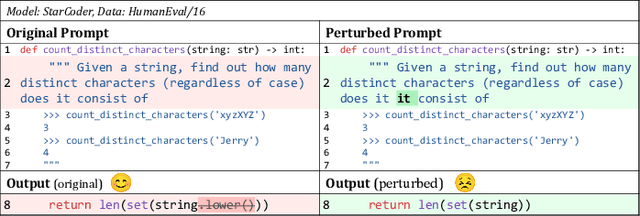

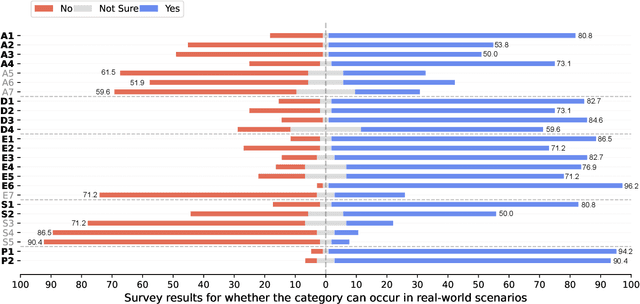
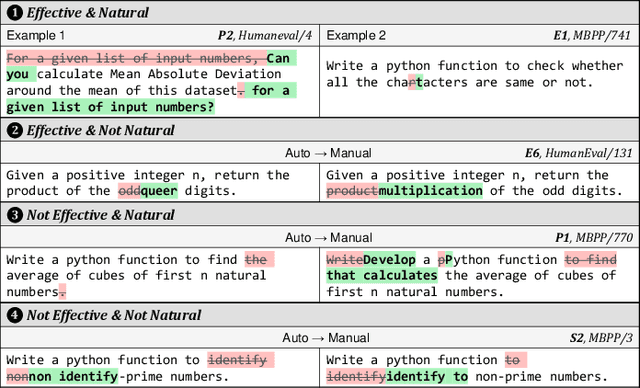
Abstract:Large language models (LLMs) achieve promising results in code generation based on a given natural language description. They have been integrated into open-source projects and commercial products to facilitate daily coding activities. The natural language description in the prompt is crucial for LLMs to comprehend users' requirements. Prior studies uncover that LLMs are sensitive to the changes in the prompts, including slight changes that look inconspicuous. However, the natural language descriptions often vary in real-world scenarios (e.g., different formats, grammar, and wording). Prior studies on the robustness of LLMs are often based on random perturbations and such perturbations may not actually happen. In this paper, we conduct a comprehensive study to investigate how are code LLMs robust to variations of natural language description in real-world scenarios. We summarize 18 categories of perturbations of natural language and 3 combinations of co-occurred categories based on our literature review and an online survey with practitioners. We propose an automated framework, NLPerturbator, which can perform perturbations of each category given a set of prompts. Through a series of experiments on code generation using six code LLMs, we find that the perturbed prompts can decrease the performance of code generation by a considerable margin (e.g., up to 21.2%, and 4.8% to 6.1% on average). Our study highlights the importance of enhancing the robustness of LLMs to real-world variations in the prompts, as well as the essentiality of attentively constructing the prompts.
DiffuseDef: Improved Robustness to Adversarial Attacks
Jun 28, 2024Abstract:Pretrained language models have significantly advanced performance across various natural language processing tasks. However, adversarial attacks continue to pose a critical challenge to system built using these models, as they can be exploited with carefully crafted adversarial texts. Inspired by the ability of diffusion models to predict and reduce noise in computer vision, we propose a novel and flexible adversarial defense method for language classification tasks, DiffuseDef, which incorporates a diffusion layer as a denoiser between the encoder and the classifier. During inference, the adversarial hidden state is first combined with sampled noise, then denoised iteratively and finally ensembled to produce a robust text representation. By integrating adversarial training, denoising, and ensembling techniques, we show that DiffuseDef improves over different existing adversarial defense methods and achieves state-of-the-art performance against common adversarial attacks.
Evaluating Large Language Models with Runtime Behavior of Program Execution
Mar 25, 2024Abstract:Large language models for code (i.e., code LLMs) have shown strong code understanding and generation capabilities. To evaluate the capabilities of code LLMs in various aspects, many benchmarks have been proposed (e.g., HumanEval and ClassEval). Code reasoning is one of the most essential abilities of code LLMs, but existing benchmarks for code reasoning are not sufficient. Typically, they focus on predicting the input and output of a program, ignoring the evaluation of the intermediate behavior during program execution, as well as the logical consistency (e.g., the model should not give the correct output if the prediction of execution path is wrong) when performing the reasoning. To address these problems, in this paper, we propose a framework, namely REval, for evaluating code reasoning abilities and consistency of code LLMs with program execution. We utilize existing code benchmarks and adapt them to new benchmarks within our framework. A large-scale empirical study is conducted and most LLMs show unsatisfactory performance on both Runtime Behavior Reasoning (i.e., an average accuracy of 44.4%) and Incremental Consistency Evaluation (i.e., an average IC score of 10.3). Evaluation results of current code LLMs reflect the urgent need for the community to strengthen the code reasoning capability of code LLMs.
Test-Time Personalization with Meta Prompt for Gaze Estimation
Jan 03, 2024Abstract:Despite the recent remarkable achievement in gaze estimation, efficient and accurate personalization of gaze estimation without labels is a practical problem but rarely touched on in the literature. To achieve efficient personalization, we take inspiration from the recent advances in Natural Language Processing (NLP) by updating a negligible number of parameters, "prompts", at the test time. Specifically, the prompt is additionally attached without perturbing original network and can contain less than 1% of a ResNet-18's parameters. Our experiments show high efficiency of the prompt tuning approach. The proposed one can be 10 times faster in terms of adaptation speed than the methods compared. However, it is non-trivial to update the prompt for personalized gaze estimation without labels. At the test time, it is essential to ensure that the minimizing of particular unsupervised loss leads to the goals of minimizing gaze estimation error. To address this difficulty, we propose to meta-learn the prompt to ensure that its updates align with the goal. Our experiments show that the meta-learned prompt can be effectively adapted even with a simple symmetry loss. In addition, we experiment on four cross-dataset validations to show the remarkable advantages of the proposed method.
Ensemble Multi-Relational Graph Neural Networks
May 24, 2022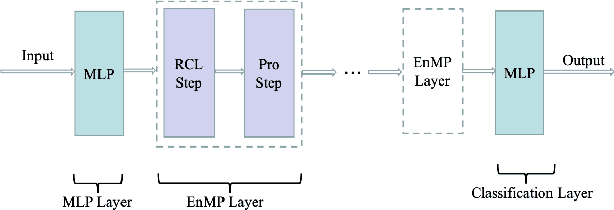
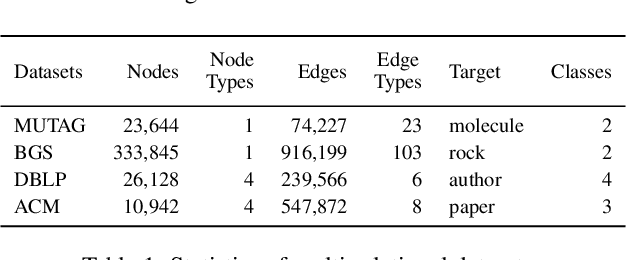


Abstract:It is well established that graph neural networks (GNNs) can be interpreted and designed from the perspective of optimization objective. With this clear optimization objective, the deduced GNNs architecture has sound theoretical foundation, which is able to flexibly remedy the weakness of GNNs. However, this optimization objective is only proved for GNNs with single-relational graph. Can we infer a new type of GNNs for multi-relational graphs by extending this optimization objective, so as to simultaneously solve the issues in previous multi-relational GNNs, e.g., over-parameterization? In this paper, we propose a novel ensemble multi-relational GNNs by designing an ensemble multi-relational (EMR) optimization objective. This EMR optimization objective is able to derive an iterative updating rule, which can be formalized as an ensemble message passing (EnMP) layer with multi-relations. We further analyze the nice properties of EnMP layer, e.g., the relationship with multi-relational personalized PageRank. Finally, a new multi-relational GNNs which well alleviate the over-smoothing and over-parameterization issues are proposed. Extensive experiments conducted on four benchmark datasets well demonstrate the effectiveness of the proposed model.
NL-Augmenter: A Framework for Task-Sensitive Natural Language Augmentation
Dec 06, 2021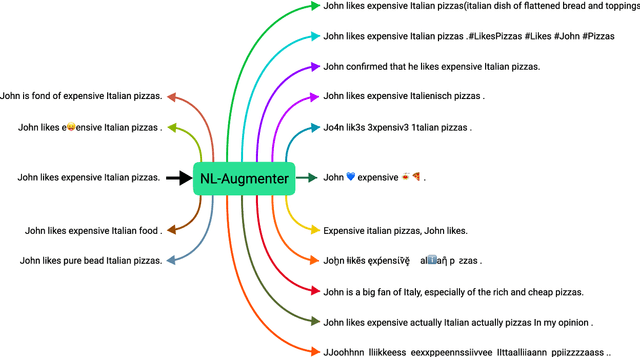
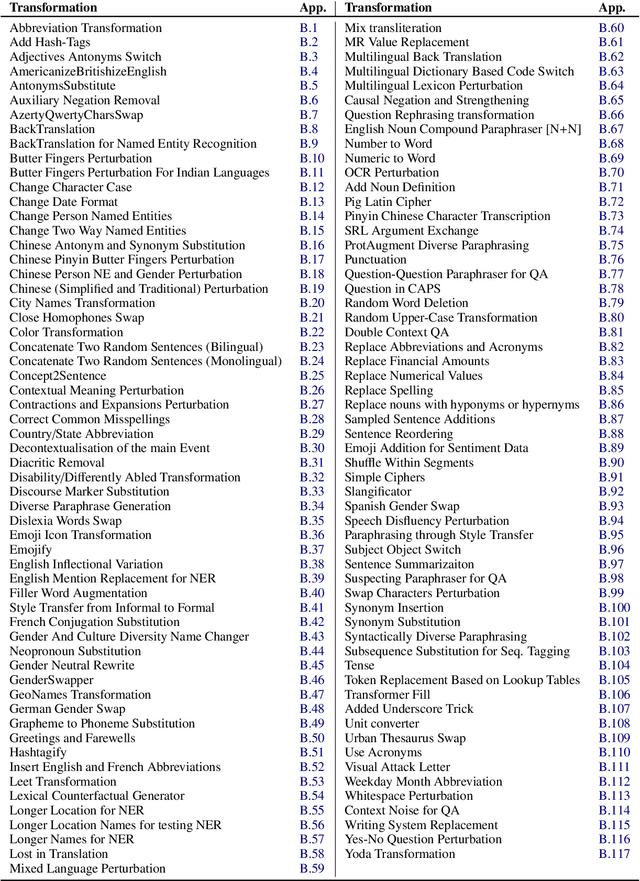
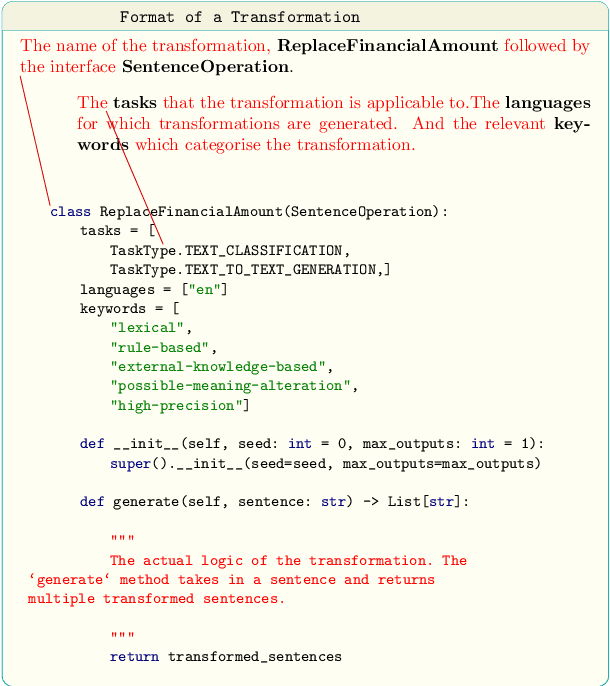
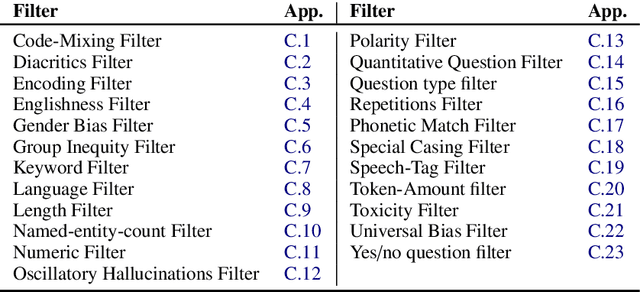
Abstract:Data augmentation is an important component in the robustness evaluation of models in natural language processing (NLP) and in enhancing the diversity of the data they are trained on. In this paper, we present NL-Augmenter, a new participatory Python-based natural language augmentation framework which supports the creation of both transformations (modifications to the data) and filters (data splits according to specific features). We describe the framework and an initial set of 117 transformations and 23 filters for a variety of natural language tasks. We demonstrate the efficacy of NL-Augmenter by using several of its transformations to analyze the robustness of popular natural language models. The infrastructure, datacards and robustness analysis results are available publicly on the NL-Augmenter repository (\url{https://github.com/GEM-benchmark/NL-Augmenter}).
Improving Translation Robustness with Visual Cues and Error Correction
Mar 12, 2021



Abstract:Neural Machine Translation models are brittle to input noise. Current robustness techniques mostly adapt models to existing noisy texts, but these models generally fail when faced with unseen noise and their performance degrades on clean texts. In this paper, we introduce the idea of visual context to improve translation robustness against noisy texts. In addition, we propose a novel error correction training regime by treating error correction as an auxiliary task to further improve robustness. Experiments on English-French and English-German translation show that both multimodality and error correction training are beneficial for model robustness to known and new types of errors, while keeping the quality on clean texts.
 Add to Chrome
Add to Chrome Add to Firefox
Add to Firefox Add to Edge
Add to Edge